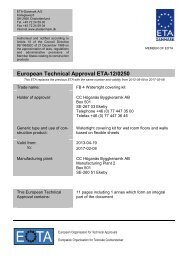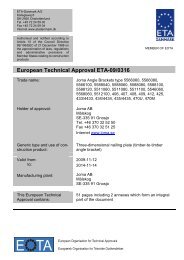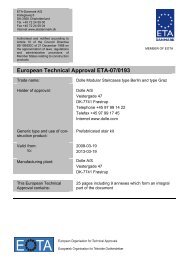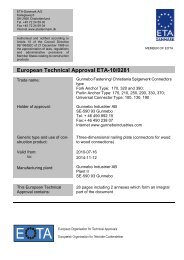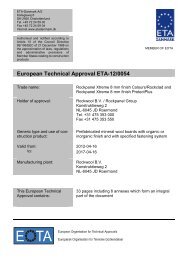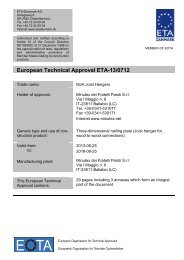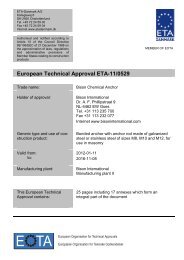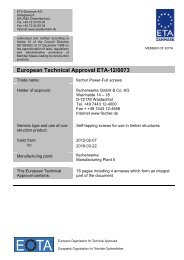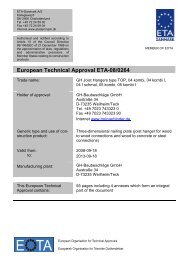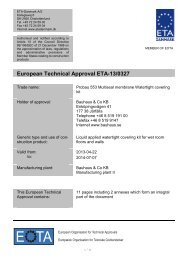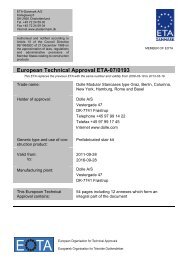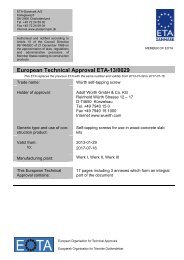ETA110030 RB screws - ETA-Danmark
ETA110030 RB screws - ETA-Danmark
ETA110030 RB screws - ETA-Danmark
Create successful ePaper yourself
Turn your PDF publications into a flip-book with our unique Google optimized e-Paper software.
Page 13 of 25 of European Technical Approval no. <strong>ETA</strong>-11/0030<br />
4 Assumptions under which the fitness of the<br />
product for the intended use was favourably<br />
assessed<br />
4.1 Manufacturing<br />
The <strong>screws</strong> are manufactured in accordance with the<br />
provisions of the European Technical Approval using the<br />
automated manufacturing process as identified during the<br />
inspection of the plant by the approval body issuing the<br />
<strong>ETA</strong> and the approved body and laid down in the technical<br />
documentation.<br />
4.2 Installation<br />
4.2.1 The installation shall be carried out in accordance<br />
with Eurocode 5 or an appropriate national code unless<br />
otherwise is defined in the following. Instructions from<br />
Rotho Blaas SRL should be considered for installation.<br />
4.2.2 The <strong>screws</strong> are used for connections in load bearing<br />
timber structures between members of solid timber<br />
(softwood), glued laminated timber, cross-laminated timber,<br />
laminated veneer lumber, similar glued members, woodbased<br />
panels or steel members.<br />
The <strong>screws</strong> may be used for connections in load bearing<br />
timber structures with structural members according to an<br />
associated European Technical Approval, if according to the<br />
associated European Technical Approval of the structural<br />
member a connection in load bearing timber structures with<br />
<strong>screws</strong> according to a European Technical Approval is<br />
allowed.<br />
Rotho Blaas fully threaded “VGS” and “VGZ” <strong>screws</strong> are<br />
also used as tensile or compressive reinforcement<br />
perpendicular to the grain.<br />
Furthermore the <strong>screws</strong> with diameters of at least 6 mm may<br />
also be used for the fixing of insulation on top of rafters.<br />
A minimum of two <strong>screws</strong> should be used for connections in<br />
load bearing timber structures.<br />
The minimum penetration depth in structural members made<br />
of solid, glued or cross-laminated timber is 4·d.<br />
Wood-based panels and steel plates should only be arranged<br />
on the side of the screw head. The minimum thickness of<br />
wood-based panels should be 1,2·d. Furthermore the<br />
minimum thickness for following wood-based panels should<br />
be:<br />
• Plywood, Fibreboards: 6 mm<br />
• Particleboards, OSB, Cement Particleboards: 8 mm<br />
• Solid wood panels: 12 mm<br />
For structural members according to European Technical<br />
Approvals the terms of the European Technical Approvals<br />
must be considered.<br />
If <strong>screws</strong> with an outer thread diameter d > 8 mm are used in<br />
load bearing timber structures, the structural solid or glued<br />
laminated timber, laminated veneer lumber and similar glued<br />
members must be from spruce, pine or fir. This does not<br />
apply for <strong>screws</strong> in pre-drilled holes.<br />
The minimum angle between the screw axis and the grain<br />
direction is α = 30°.<br />
4.2.3 The <strong>screws</strong> shall be driven into the wood with or<br />
without pre-drilling. The maximum pre-drilling diameter is<br />
the inner thread diameter for the length of the threaded part<br />
and the smooth shank diameter for the depth of the smooth<br />
shank. The hole diameter in steel members must be<br />
predrilled with a suitable diameter.<br />
Only the equipment prescribed by Rotho Blaas SRL shall<br />
be used for driving the <strong>screws</strong>.<br />
In connections with <strong>screws</strong> with countersunk head<br />
according to Annex A the head must be flush with the<br />
surface of the connected structural member. A deeper<br />
countersink is not allowed.<br />
4.2.4 For structural timber members, minimum spacing and<br />
distances for <strong>screws</strong> in predrilled holes are given in EN<br />
1995-1-1:2008 (Eurocode 5) clause 8.3.1.2 and table 8.2 as<br />
for nails in predrilled holes. Here, the outer thread diameter<br />
d must be considered.<br />
For <strong>screws</strong> in non-predrilled holes, minimum spacing and<br />
distances are given in EN 1995-1-1:2004 (Eurocode 5)<br />
clause 8.3.1.2 and table 8.2 as for nails in non-predrilled<br />
holes.<br />
For Douglas fir members minimum spacing and distances<br />
parallel to the grain shall be increased by 50%.<br />
Minimum distances from loaded or unloaded ends must be<br />
15·d for <strong>screws</strong> in non-predrilled holes with outer thread<br />
diameter d > 8 mm and timber thickness t < 5·d.<br />
Minimum distances from the unloaded edge perpendicular<br />
to the grain may be reduced to 3·d also for timber thickness<br />
t < 5·d, if the spacing parallel to the grain and the end<br />
distance is at least 25·d.<br />
Minimum distances and spacing for exclusively axially<br />
loaded <strong>screws</strong> in non-predrilled holes in members with a<br />
minimum thickness t = 12·d and a minimum width of 8·d<br />
or 60 mm, whichever is the greater, may be taken as:<br />
Spacing a1 parallel to the grain a1 = 5 · d<br />
Spacing a2 perpendicular to the grain a2 = 5 · d<br />
Distance a1,c from centre of the screw-part in<br />
timber to the end grain a1,c = 10 · d



